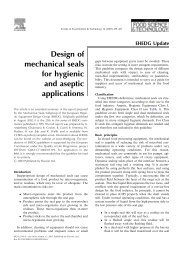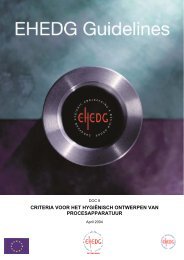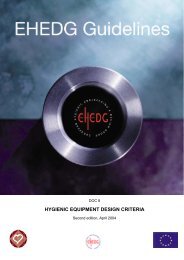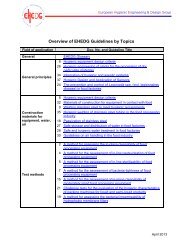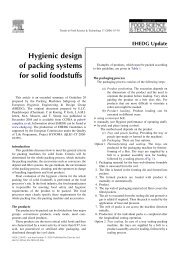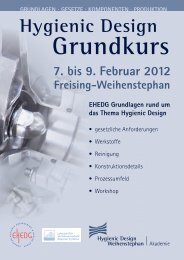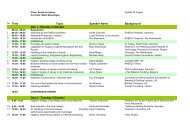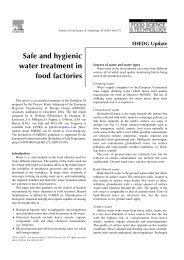Yearbook 2013/2014 - ehedg
Yearbook 2013/2014 - ehedg
Yearbook 2013/2014 - ehedg
You also want an ePaper? Increase the reach of your titles
YUMPU automatically turns print PDFs into web optimized ePapers that Google loves.
European Hygienic Engineering & Design Group<br />
Environmentally friendly water based surface<br />
disinfectants<br />
Markets fluctuate. Requirements change. And this is especially true in the highly sensitive areas<br />
of cleaning and hygiene in the production and preparation arms of the food industry. Demand is<br />
for innovative solutions and cost-saving methods that conserve resources, are environmentally<br />
friendly, do not cause undue side effects to humans and are as safe as possible for the users.<br />
Stephan Mätzschke, Dipl.- Oecotrophologist (FH), Member of the Management Board at BIRFOOD GmbH & Co. KG<br />
E-mail: s. maetzschke@birfood.de, Tel.: + 49 421 489 960 17<br />
The cleaning and disinfection of production plants in the<br />
meat handling industry are two intrinsically linked processes<br />
required to guarantee the proper hygienic production of food<br />
in line with regulations. At a time when ultimate consumption<br />
date periods are getting longer and the requirements from<br />
legislators, trade and consumers are continually increasing,<br />
producers are forced to take the hygiene measures that<br />
accompany their production processes to a new level.1<br />
It is standard practice in the meat handling industry today that<br />
after thorough cleaning the production plant is chemically<br />
disinfected using either a foam or a spray. Currently a whole<br />
range of chemical disinfectants is available to the food<br />
industry, but despite the choice of products available, this<br />
article will highlight the difference between two disinfection<br />
methods: the inhibitive methods and the destructive methods.<br />
Some active agents like quaternary ammonium compounds<br />
or aldehydes, for example, have an inhibitive effect on<br />
bacterial cells. This means that these substances do not<br />
destroy the bacterial cells; instead, they prevent their<br />
reproduction by disrupting the cellular metabolism. Such<br />
substances are generally suitable for use on most surfaces<br />
and are user friendly; however, there are gaps in their<br />
effectiveness. Certain groups of germs are less susceptible<br />
to them and if the agents are used incorrectly, particularly if<br />
the wrong concentration is used over a long period of time,<br />
there is a risk that the bacteria will build up a resistance to<br />
them.<br />
The alternative group of active agents have a destructive<br />
effect; specifically, these agents destroy the bacterial cells.<br />
Active agents like peracetic acid, hydrogen peroxide and<br />
sodium hypochlorite belong to this group. This group of<br />
active agents has a broad spectrum of effectiveness and<br />
there is no danger of resistance if the products are used<br />
incorrectly. However, these agents are highly corrosive<br />
and are therefore dangerous to use on material (especially<br />
aluminium and non-ferrous metals) as well as for the user.<br />
A further disadvantage is their relative instability in the<br />
presence of organic matter.<br />
Non-hazardous water based surface<br />
disinfectants<br />
In contrast to the meat handling industry, the disinfection of<br />
drinking water and the drinking water supply network has<br />
been carried out for years using electrochemical activation<br />
(ECA) technology as an alternative to chemical disinfection.<br />
ECA technology frequently is used successfully in countries<br />
with precarious water supplies and in very warm climates, as<br />
well as in buildings with irregular water consumption where<br />
the water in the pipes must be held for longer periods (e.g.,<br />
hotels) as a reliable way of protecting against Legionella<br />
and other germs. The idea of using this technology as an<br />
environmentally or user-friendly alternative to the chemical<br />
disinfection of surfaces in the meat handling industry is<br />
relatively new.<br />
How ECA technology works<br />
The ECA technology is based on the treatment of drinking<br />
water by electrolysis. During the electrolysis process redox<br />
potential is generated by applying an electric voltage<br />
(Figure 1). This redox potential imparts the resulting flow of<br />
microbiocidal properties.<br />
Figure 1. Electrolysis process.<br />
During a redox reaction (effectively a reduction oxidation reaction)<br />
an electron from one reactant is transferred to the other. As one<br />
reactant is reduced, the other oxidises. The redox potential (in this<br />
case, 1200 mV) serves as an indicator of the extent to which such<br />
an electron transfer between reactants can take place. In doing so,<br />
it also demonstrates to a certain extent the level of the solution’s<br />
microbiocidal activity. When apparatus that has been treated with<br />
the solution produced with ECA technology comes into contact with<br />
bacterial cells, electrons will be transferred. The bacterial cell will<br />
oxidise and die.<br />
The ECA solution works in the same way as peracetic<br />
acid, hydrogen peroxide or sodium hypochlorite: that is,<br />
destructively. It oxidises the bacterial cell and with that, it<br />
dies. The advantage of ECA technology over these other<br />
solutions is that it is neither a corrosive nor an irritant for<br />
material or users. It complies with the German Drinking Water<br />
Directive because it does not contain anything dangerous.



